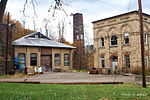Barrelville, Maryland
Allegany County, Maryland geography stubsCensus-designated places in Allegany County, MarylandCensus-designated places in MarylandUse mdy dates from July 2023
Barrelville (historically sometimes known as Pamosa) is an unincorporated community and census-designated place (CDP) in Allegany County, Maryland, United States. As of the 2010 census, it had a population of 73. It is located between Corriganville and Mount Savage, where an 1804 road from Pennsylvania intersected the legendary Turkey Foot Road. Jennings Run flows from Mount Savage to Barrelville, where another tributary that runs south from Wellersburg, Pennsylvania, joins Jennings Run.
Excerpt from the Wikipedia article Barrelville, Maryland (License: CC BY-SA 3.0, Authors).Barrelville, Maryland
Barrelville Road Northwest,
Geographical coordinates (GPS) Address Nearby Places Show on map
Geographical coordinates (GPS)
| Latitude | Longitude |
|---|---|
| N 39.701666666667 ° | E -78.8425 ° |
Address
Barrelville Presbyterian Church
Barrelville Road Northwest
15564
Maryland, United States
Open on Google Maps








